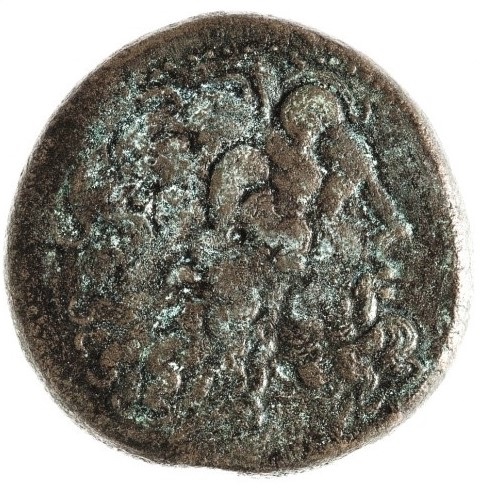Title: Coin of Ptolemy IV Philopator - 1986.05
Acquisition number: 1986.05
Author or editor: Douglas Kelly
Culture or period: Ptolemaic Egypt.
Date: 222 - 204 BC.
Material: Metal - Bronze
Object type: Coins - Greek
Dimensions: 38mm (w)
Origin region or location: Egypt
Display case or on loan: 5
Keywords: Coin, Greek, Egypt, Ptolemy IV, Zeus, Ammon
Sylloge Nummorum Graecorum, Copenhagen, The Royal Collection of Coins and Medals, Danish National Museum, repr. edn (West Milford, NJ, 1981-), 221 - 228.
R. S. Poole, Catalogue of Greek Coins: The Ptolemies, Kings of Egypt (London, The British Museum, 1883), Ptolemy IV, no.37.
1986.05
Coin of Ptolemy IV Philopator
Copper/bronze, 39.13 g. 38 mm. 222-204 B.C.
Obv. Head of Zeus Ammon r., with diadem.
Rev.: Eagle standing on thunderbolt facing left, wings partly open and head turned back r.; cornucopiae by left wing. ΠΤΟΛΕΜΑΙΟΥ ΒΑΣΙΛΕΩΣ (‘of King Ptolemaios’). Between eagle’s legs: Ε.
The inscription is ‘of Ptolemy the King’; the Ε may be a numeral (5) or a mintmark with substantial new issues. There is considerable variation in the diameters and weights of surviving specimens of the Alexandrian heavy bronzes of this period but no obvious indication of denomination.
Ammon was the god of the celebrated oracle shrine at Siwa in the Libyan desert, which long had attracted Greeks and had been visited by Alexander in 332 BC. Ammon, recognizable by his horns, had the ram as his symbol. He was often identified with Zeus, as Zeus Ammon, but on Ptolemaic coinage a distinction needs to be made.
The order ‘Ptolemy the King’ had been used by the revered founder of the dynasty and remained standard Ptolemaic usage.
Sylloge Nummorum Graecorum, Copenhagen, The Royal Collection of Coins and Medals, Danish National Museum, repr. edn (West Milford, NJ, 1981-), 221 - 228.
R. S. Poole, Catalogue of Greek Coins: The Ptolemies, Kings of Egypt (London, The British Museum, 1883), Ptolemy IV, no.37.

